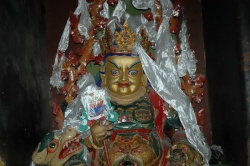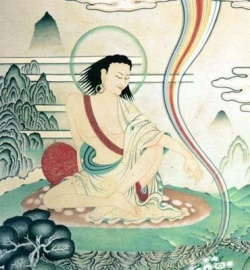Embracing the Growing Profile of Chinese Buddhism
Following the success of the First View-sharing Meeting on Chinese Buddhism, held at Fayuan Temple in Beijing in April 2008, this October’s second meeting at the West Lake of Hangzhou achieved equal success. Hangzhou has long been deemed a city with profound influence. Its picturesque West Lake was highly acclaimed by Su Dongpo, the great poet of the Song Dynasty. He versed "Of all the thirty-six west lakes in this country, here in Hangzhou is the best". Its economic prosperity was praised by Marco Polo, the famous traveler in the Yuan Dynasty, as "the most beautiful and magnificent city in the world". However one of the greatest contributions of this city and its culture is through nurturing resplendent elites, including those masters immortal in the history of Chinese Buddhism such as Ven. Yan Shou, Ven. Xing Chang and Ven. Zhu Hong. Holding the View-sharing Meeting in Hangzhou reflects us continuing in the steps of our predecessors, dedicating our actions to propagating the Buddha-Dharma and benefiting humankind.
Buddhism took its root in China and has played a unique role the civilization’s 2000-year history. The essence of Buddhism, where by the common people can transcend themselves by being attentive to the outside world and reflecting on their inside world, coincides with the Chinese cultural background. For example,maintaining one’s integrity in obscurity while making perfect the world in times of success. Re-examination of the role that Buddhism has played may help us understand the significance and value of the present View-sharing Meeting. Development of Buddhism in China may be roughly divided into four stages: the 1st stage is the Wei, Jin, Southern and Northern Dynasties----the spring when it takes root and germinates; the 2nd stage is the Sui and Tang Dynasties---- the summer when it grows into great prosperity; the 3rd stage is the Song and Yuan Dynasties----the autumn when it blossoms and bears fruit; the 4th stage---- the winter when leaves fall to return to their roots.
The 1st stage: the spring when Buddhism takes root and germinates.
After more than 300 years of predominance the customs and restraints on moral virtues of Confucianism had become rigid. Thus the thought of Taoism upholding a natural and inactive way of living returned to the mainstream. This laid a solid foundation for propagating the “no-self” concept of Buddhism. At this stage, the development of Buddhism in China was mainly reflected in the translation and interpretation of scriptures. Prominent figures in the translation of scriptures included An Shigao, Dharmaraksita and Kumarajiva. Prominent figures in interpretation included Dao An, Hui Yuan and Seng Zhao.
Due to the unique cultural background of China, the approach of “matching the meanings” had been taken, consciously or not, in the translation and interpretation of scriptures. Through this approach, scriptures were presented with local languages and their contents are thus familiar and understandable to the local people. Therefore at the very beginning of its introduction into China, Buddhism already possessed local characteristics and thus planted its root.
We found that at this stage those who contributed extraordinarily to the translation of scriptures were often monks from countries of the Western Region. They were not only highly accomplished in Buddhism but also well-versed in the language and culture of China. Among those who made outstanding contributions to the interpretation of scriptures were Chinese, such as Dao An and Seng Zhao. They had achieved deep understanding of local culture like Confucianism and Taoism, and could comprehend scriptures of Buddhism in a comprehensive and flexible manner.
The 2nd stage: the summer when Buddhism grows into great prosperity.
While having caused great suffering to the people, the turmoil of the Wei, Jin, Southern and Northern Dynasties advanced the syncretism of Buddhism and the local culture to a great extent. Buddhism spread with movement of the people and when the entire country united and prospered once again, Buddhism also flourished. At this stage, the development of Buddhism was characterized by the establishment of schools of Buddhism and the evaluation of Buddhism scriptures. The eight schools of Mahayana Buddhism in the history of Chinese Buddhism were established during this period. For instance, Three Treaties School founded by Master Ji Zang, Tian Tai School by Master Zhi Zhe, Pure Land School by Master Shan Dao, Xian Shou School by Master Fa Zang, etc.
There are at least two reasons why those Masters were able to develop a school of their own. Firstly, as generations passed the interpretive approach of “matching the meanings” in Buddhism was gradually abandoned. This led to the return to the fundamental doctrines. For instance, the thought of “Middle Way Buddha Nature” by Master Ji Zang was influenced by Sungnang, Seng Quan and Pomnang. The thought of “Perfect Interfusion of the Three Truths” by Master Zhi Zhe has the same origin as those of Hui Wen and Hui Si. The doctrine of “Origin of Dharmadhatu” by Du Shun and Zhi Yan had been inherited by Master Fa Zang. Secondly, most of those masters who establish schools of thoughts became monks in their childhood. They became erudite in Buddhist canon, possessing a wide knowledge of different schools and sects, and therefore being able to strike out their own path by drawing on all schools for thought. For example, Master Ji Zang followed Pomnang and became a monk at seven years old. He researched intensively on Three Treaties and understood thoroughly scriptures such as Lotus Sutra, Avatamsaka Sutra, Nirvana Sutra and Mahaprajnaparamita Sutra. Master Shan Dao also entered the religion as a child and familiarized himself with Lotus Sutra and Vimalakirtinirdesa Sutra, based on which he reached a comprehensive understanding of Sutra of the Visualization of the Buddha of Infinite Life.
This stage of Chinese Buddhism flourished through the parallel development of these different schools. All emphasized research of the succession of previous schools of thought while attaining thorough knowledge of all Buddhist sutras and focusing on one or a few scriptures and treaties. Thus Chinese Buddhism flourished.
The 3rd stage: the autumn when Buddhism blossoms and bears fruit.
The prosperity of Buddhism in the Sui and Tang Dynasties was brought to an end by the general destruction ordered by Emperor Wuzong of Tang Dynasty. During that period, both Buddhism temples and scriptures were severely damaged, and a large number of monks were forced to resume secular life. The successions of different schools of Chinese Buddhism were also interrupted. An exception to this general decline was the Zen School. It had become successfully domesticated as early as the mid Tang Dynasty and was much less dependent on society. At this time, the Zen School performed Buddhism in a unique fashion ---- “transmitting without the use of letters and outside scriptures”---- which had less reliance on scriptures than other schools, and was thus saved from the social turbulence at the end of Tang Dynasty. The following Song and Yuan Dynasties, a period of nearly 400 years, became the golden period for the development of the Zen School.
There are two reasons for which we regard this period as a time Buddhism blossoms and bears fruit. Firstly, many new sects of the Zen School emerged during this period. Moreover, a string of founders experienced enlightenment. Secondly, the full-fledged theory of Mind Nature of Buddhism was able to benefit wider society, contributing to the renovation of local culture and the emergence of a more complete theory of Neo-Confucianism from that of the Song and Ming Dynasties.
The representative figures of this period are Zen Master Yong’an Qisong of Yun Men School, Zen Master Dahui Zonggao of Lin Ji School, and Zen Master Wansong Xingxiu of Cao Dong School. Their contributions to the development of Buddhism have some common characteristics. First, on theory constructions, the Zen Masters all emphasized the integration of the three religions and the coherence between Confucianism and Buddhism, and often elaborated in full detail the syncretism of Dharma and the rules of secular world. Thanks to their efforts, Buddhism eventually became one of the pillars of Chinese traditional culture. Second, in terms of the propagation of Dharma, the Zen Masters attached more importance to its influence on the literati and officialdom. This helped create a favorable environment for the development of Buddhism and lay a sound foundation for its propagation among ordinary people.
The 4th stage: the winter when leaves fall to return to their roots.
After near 400 years’ development during Song and Yuan Dynasties, Zen School gradually exposed many drawbacks and went to decline owing to lack of attention to scriptures and disciplines. It was replaced by Pure Land School, which flourished in Ming and Qing Dynasties. This is evidenced by the fact that of the thirteen founders of Pure Land School, only one appeared in the early period of Song and Yuan Dynasties while six in Ming and Qing Dynasties. Moreover, most of the Zen Masters of Ming and Qing Dynasties advocated performing Zen School and Pure Land School simultaneously and their faith in Pure Land School was gradually strengthened. Being easy to understand and to practice, Pure Land School was well received by wide spectrum of society, especially people at the foot of social ladder. As a result, Buddhism expanded its realm beyond Buddhist groups and the literati and officialdom, and entered into daily life of ordinary people showing an apparent secular trend. For this reason we regard this period as a time when leaves fall to return to their roots.
During this period, the representative figures are two masters---- Yunqi Zhuhong and O’yi Zhixu. Their common characteristic was in advocating the syncretism of various Schools of teaching, rules of discipline and meditation, and to reach Sukhavati through industrious cultivation. In the face of internal disturbance and foreign aggression in the Republican Period, this characteristic led to the brief revival of various Schools of Buddhism during this period and the emergence of “earthly Buddhism” advocated by Master Tai Xu.
Until the founding of the New China, the about 2000 years’ development of Buddhism in China had experienced a burgeoning spring, a flourishing summer, a fructifying autumn and a settled winter, and thus completed the circle. Since the inception of the New China, particularly after more than 30 years’ reform and opening, the demand for cultural prosperity became increasingly strong while the economy growing rapidly and the politics becoming more and more open-minded. This heralds the coming of the spring for the development of Buddhism. Whether we can take this rare chance to find a healthy and vigorous way for the development of Buddhism is an important topic for every Buddhist. Future can be revealed in retrospect. We should receive precious inspirations by reviewing the evolution of Buddhism in the past.
First of all we face the question of how to interpret scriptures in the new context. This reflects the situation facing Buddhism when it first entered into China. Had it been inappropriately interpreted, misunderstood and abandoned, the evolution of Buddhism in China would not have taken place. Today we are facing the same problem. Dramatic changes of times have happened in China. Although the meanings of scriptures are eternal, it is a challenge to describe it in a language consistent with modern mentality, in an accessible manner and to both analyze and expound new scenarios in conformity with the meanings of the scriptures. One of the main purposes of this nationwide view-sharing meeting is to boost the interpretation of scriptures in the context and ethos of new times, as well as showing the value of scriptures for these times.
The second and perhaps more important question is the globalization of Buddhism. Historically, the main barrier to Buddhism in China was domestication and the syncretism of the thoughts of Buddhism, Confucianism and Taoism. In fact this process has been completed. Today when we talk about the globalization of Buddhism, it’s no longer syncretism of thoughts. The question is how Chinese Buddhism, Tibetan Buddhism and Hinayana Buddhism can draw experiences and complement each other. Also how Buddhism, Christianity, Islam and thoughts of western philosophy should exchange and learn from each other. Such dialogue is crucial to the future of Buddhism. Not taking action could have detrimental consequences.
For a long period following Buddhism’s introduction to China, translation of scriptures was mainly carried out by monks from the countries of the Western Region. They were well-versed in Chinese language and culture. Without their efforts, it is not clear whether Buddhism could have taken its root in China. This tells us that in order to achieve the globalization of Buddhism, we have to reach out actively to peoples of different regions of the world, learning their languages and understanding their cultures. By translating scriptures in a manner accessible to local people, their language, culture and mentality, Buddhism may gradually take root in every region of the world. I believe this is a sacred mission that every Buddhist should undertake. Only after the accomplishment of this mission will an opportunity for a great growth in Buddhism come.
Aware of it or not, we are now positioned on a new starting point in time. From this perspective, those participating in today’s meeting are not only sharing their views on scriptures but are also showing a sense of responsibility for our times. Let us make a united effort to accomplish this mission.
Thank you!
Translator: Yin Wenjuan
Proofreader: Nicky Bex




